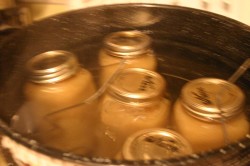Week 43: APPLES Do something with all those apples. Pie, applesauce, juice, canned apples with sugar are good.
Homemade Applesauce Recipe and Canning Instructions
Step 1: Get your pot ready
Use your biggest pot and put a little water in the bottom to keep the apples from sticking. As you peel the apples just started throwing them in to start cooking.
Step 2: Peel a TON of apples
Just as a reference, used about 14 pounds of apples (before coring/peeling) and it netted 5 quarts of applesauce.
Step 3: Cook up those apples
By the time you are done peeling all the apples the first ones were really well cooked. Just let the whole thing cook for about 10 more minutes to make sure they were all soft.

Step 4: Prepare your canner and jars
While the apples are cooking run your bottles in the dishwasher to sterilize them. Fill up your canner and started to boil the water. Lastly, Start some small pots of water boiling to sterilize the lids and rings. If you are new to canning, I would HIGHLY recommend getting a Home-Canning Kit to get all the tools you need to do proper canning. If you don’t have a canner or jars yet you can buy anall-in-one kit which will include EVERYTHING you need to get started!
Step 5: Make the applesauce!
Once the apples were all soft, use a mixer to puree them. You could also use a food processor or even a blender to do the pureeing. At this point you can add any seasonings you want. I added 2 cups of sugar but could have gotten away with just one. Ours turned out really sweet and delicious. Some people like to add cinnamon or other things but I prefer to just add those when we eat it.
Step 6: Pour the applesauce into jars and seal ‘em up
Use a funnel as this can get really messy. Ladled the applesauce in leaving about 1/2 an inch of space at the top of the jars. Then used tongs to pull out a lid and ring for each jar. Try not to touch these things with bare hands as you don’t want them to get unsterilized. Screw the ring on tight once the lid is on.

Step 7: Put your jars into your canner and boil (make sure the water goes ABOVE the jars.
As you fill each jar you would put it into the canner. As you put more jars in the water level rises, so you don’t need to start with the canner all the way full. Once all 5 jars in fill up the canner to cover the jars with hot water. Wait until the water is boiling before you start timing. Let it boil for 20 minutes and then remove the jars. Way easy huh?

Apples are best stored at 30°- 32°F, with a relative
humidity of 90 percent and some air circulation. These
conditions provide the greatest delay in the normal ripening and aging process of the fruit.
Such conditions are necessary because an apple is not
dead at the time of harvest. It remains a living, respiring organism and continues to take in oxygen and give
off carbon dioxide and another gas, ethylene. Since the
apple is no longer receiving nutrients from the tree but is
still respiring, it must use up the food it has stored over
the growing season. As this food is gradually used up
during storage, the sugar, starch, and acid content of
the apple changes. Eventually the tissues break down
(a process enhanced by ethylene gas), water is lost, and
the apple withers and decays. The low temperature, high
humidity, and exchange of gases through air circulation serve to slow those natural events as much as possible.
Containers for Apple Storage
Small quantities of apples are best stored in plastic bags.
The bags should have some holes or perforations for air
circulation to avoid excess moisture build-up and allow
gas exchange.
Large quantities of apples can be stored in crates or
other containers if the overall storage environment is
maintained at 90 percent relative humidity. The containers should be clean and have smooth inner surfaces.
Protrusions such as staples or nails can cut or bruise fruit
and cause early breakdown. Stackability is important for
large quantity storage. Containers should stack so that air
can circulate freely and so that the weight is borne by the
container and not the fruit inside.

No comments:
Post a Comment